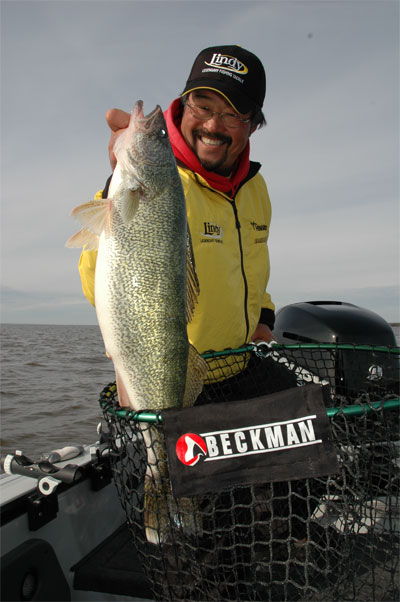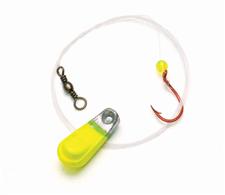The Art of Lindy Rigging
May 9th, 2011 by OutdoorsFIRST
Modified May 9th, 2011 at 12:00 AM
Champion walleye fisherman and Lindy pro staffer Ted Takasaki has been fishing the Lindy Rig for more than a quarter century. It continues to be one of his go-to walleye tactics.
 |
|
|
|
That’s saying something when you consider that competitive walleye tournaments have brought about many advanced methods, such as trolling with in-line planer boards. “There’s never been any need to change the basic Lindy Rig,” Takasaki says. “It’s a simple, but highly efficient, live bait delivery system.”
Lindy Walking Sinker
The heart of the Lindy rig is the Lindy Walking Sinker. Its unique shape allows it to walk over rocks and other snaggy bottoms without hanging up.
Every serious walleye fisherman needs Lindy Walking Sinkers in 1/8- through 3/4-ounces sizes to cover various depths. Takasaki typically uses the 1/4-ounce size when fishing 10 feet deep or less, the 1/2-ouncer in 10 to 20 feet of water, and the 3/4-once sinker when fishing deeper than 20 feet.
You can go with the basic unpainted Lindy Walking Sinker or opt for a painted model in chartreuse, orange or glow. Some walleye fishermen prefer a brightly colored sinker in dingy water.
Takasaki fishes the Lindy Rig with a 7-foot, medium-light St. Croix Legend Xtreme spinning rod and an Ardent S2500 reel spooled with 10-pound Tuf-Line DuraCast. The no-stretch braided line makes for super sensitivity and sure hook sets.
After Takasaki threads his line through a Lindy Walking Sinker, he ties it off to a Lindy Swivel-Clip. The clip on the tail end of the swivel lets you securely attach the end loop of a Lindy Rig Snell without tying a knot.
Lindy Rig Snell
“The original 36-inch Lindy Rig Snell usually does the job for me,” Takasaki says. “If I’m fishing where the hook is snagging in rocks, I’ll cut it down to 24-inches.”
 |
|
|
Lindy Rig
|
Leeches, minnows and crawlers all dupe walleyes with the Lindy Rig. Takasaki hooks leeches through the sucker and minnows through the lips or the tail. He threads the hook about 1/4-inch into the nose of a crawler and out the side, just deep enough so the crawler’s nose covers the hook’s eye and the knot.
Hitting the Spot
When walleyes scatter over a large flat or suspend in open water, Takasaki pulls spinner rigs or crankbaits to cover more ground. It is when walleyes concentrate in key places that he makes hay with the Lindy Rig.
“The Lindy Rig also shines when walleyes are in a negative or neutral mood after a cold front,” Takasaki says. Walleyes congregate on what Takasaki calls “the spot-on-the-spot.” An example would be a straight breakline (drop-off) that has one little rocky point that juts out, or maybe a flat spot or a patch of grass.
When Takasaki finds one of these sweet spots, he pulls a Lindy Rig back and forth over it. His LCG, GPS and bow-mounted electric motor allow him to do so with precision.
Pulling Pace
A slow pace keeps the Lindy Walking Sinker bumping along the bottom and the trailing bait down where it tempts walleyes. It also gives walleyes plenty of time to react to the bait, even negative and neutral fish.
“I usually go from about 1/4 to 1/2 mph,” Takasaki says. “The line from my rod tip to the water is maybe 60 degrees, just a little past vertical.” Although Takasaki usually drags bottom with the sinker, he occasionally pulls it up 2 to 12 inches. “Sometimes walleyes want the bait floating above their nose,” Takasaki says.
Direction
When Takasaki pulls spinners or cranks for scattered walleyes, he often follows a breakline. Or, if he has found the depth at which the walleyes are feeding, he may follow a specific bottom contour, say, 15 to 18 feet.
However, Takasaki fares better with the Lindy Rig by pulling it uphill and downhill after he’s pinpointed a school of walleyes. If the walleye are holding on the edge of drop that goes from 15 to 25 feet deep, Takasaki pulls his Lindy Rig uphill from 25 feet deep and over the edge of the drop.
Then turns his boat around and pulls his Lindy Rig back over drop and back downhill into the 25 feet of water. “Walleyes on the edge of a structure often prefer the bait coming up a drop or down it,” Takasaki says. “Crisscrossing a drop-off also keeps you in touch with the walleye if they move deeper for some reason.”
Crisscrossing paid off for Takasaki a few years ago when he fished an FLW walleye tournament at Leech Lake. He was Lindy Rigging a big chub minnow over two points that topped out at 20 feet deep. The points were separated by a saddle that was 50 feet deep. By repeatedly pulling his Lindy Rig back and forth across the points and the saddle, Takasaki finished in 11th place. He also brought in a huge walleye that weighed over 8 pounds.
Moment of Truth
The most challenging aspect of Lindy Rigging is keeping your cool when you feel a walleye take the bait. When Takasaki pulls a Lindy Rig, he opens the bail of his spinning reel and lets out enough line to keep the sinker in contact with the bottom.
He leaves the bail open and holds the line with his forefinger while pulling a Lindy Rig. This helps him sense bites and react faster to them. “When I feel a bite, I immediately let the line slip off my finger, drop the rod tip and pull a few feet of line off the reel,” Takasaki says.
This is where the simple genius of the Lindy Walking Sinker comes into play. As the walleye swims off with the bait, the line slides through the sinker. The walleye feels no resistance that would cause it to drop the bait.
“With the first bite of the day, I typically let the walleye take the bait for 5 to 10 seconds,” Takasaki says. “You have to give a walleye time to get the hook in its mouth.”Then Takasaki cautiously turns the boat around to get on top of the walleye as he points the rod at the fish and slowly reels up slack line. When the rod starts to bend, he sets the hook.
If he misses the walleye, Takasaki waits 15 to 20 seconds before setting the hook on the next fish. He gradually increases the length of his wait until his grabs hold. When walleyes are in a funk, he may have to wait 60 seconds or more. “You can’t beat a Lindy Rig for catching those finicky biters,” Takasaki says.